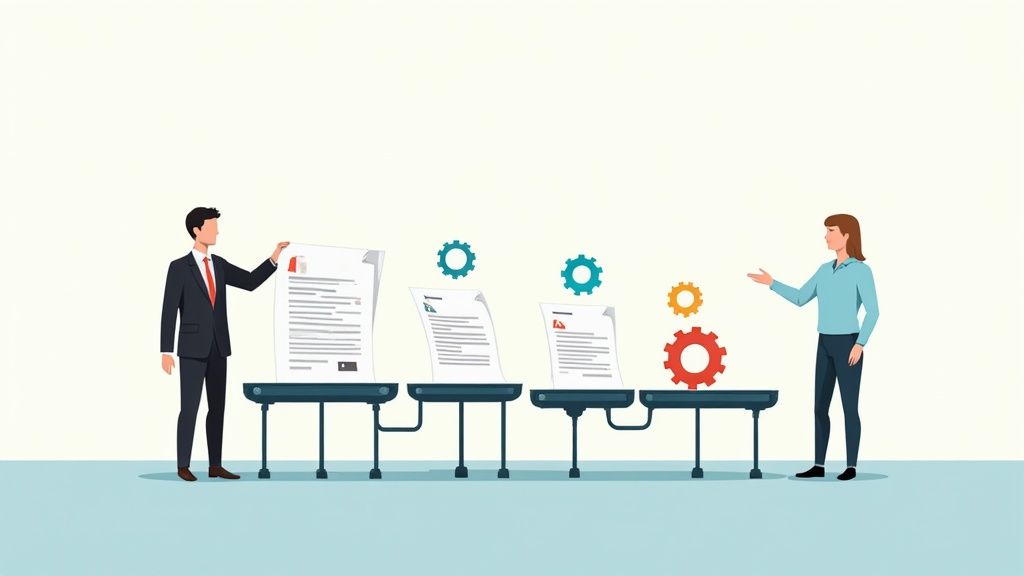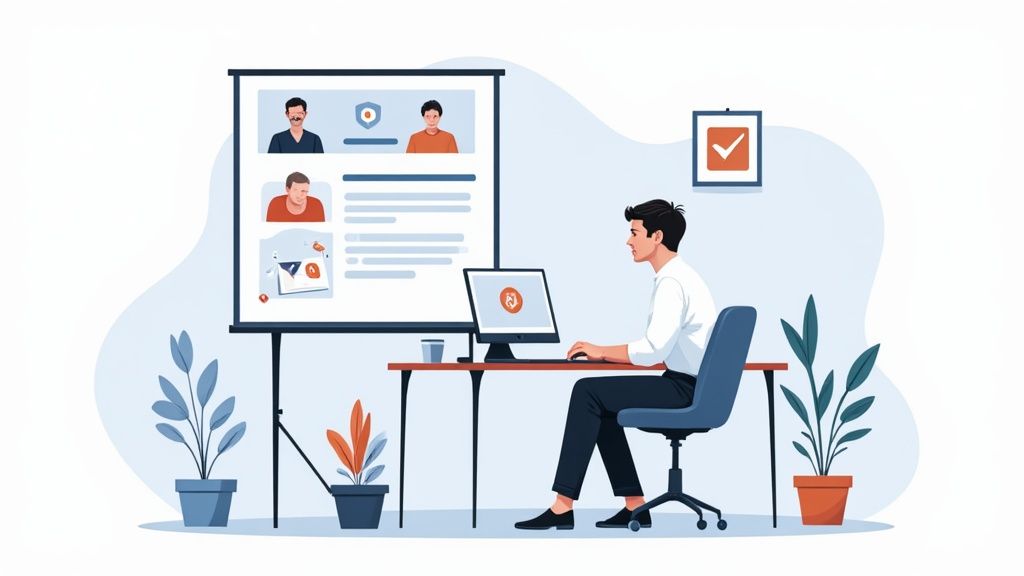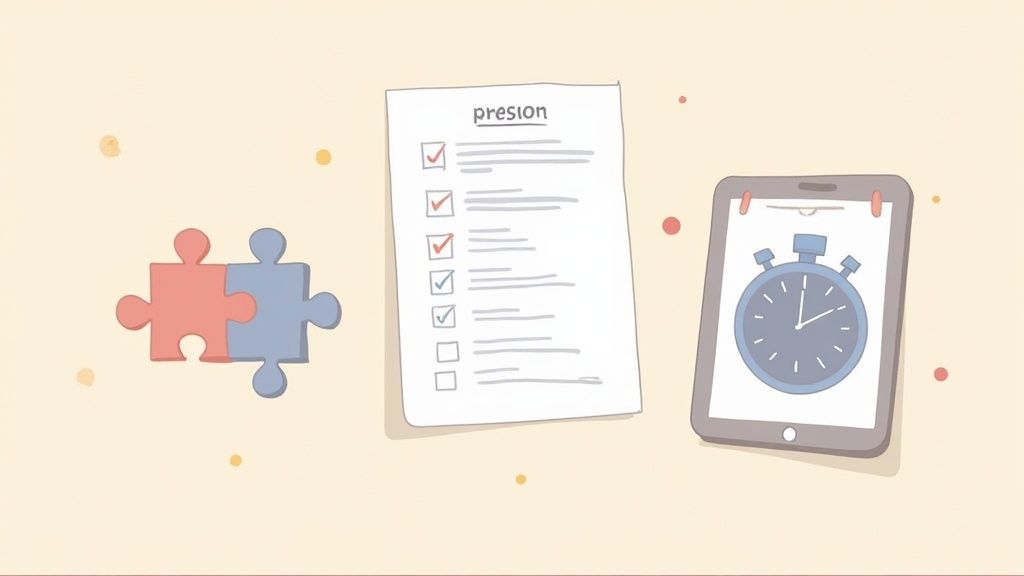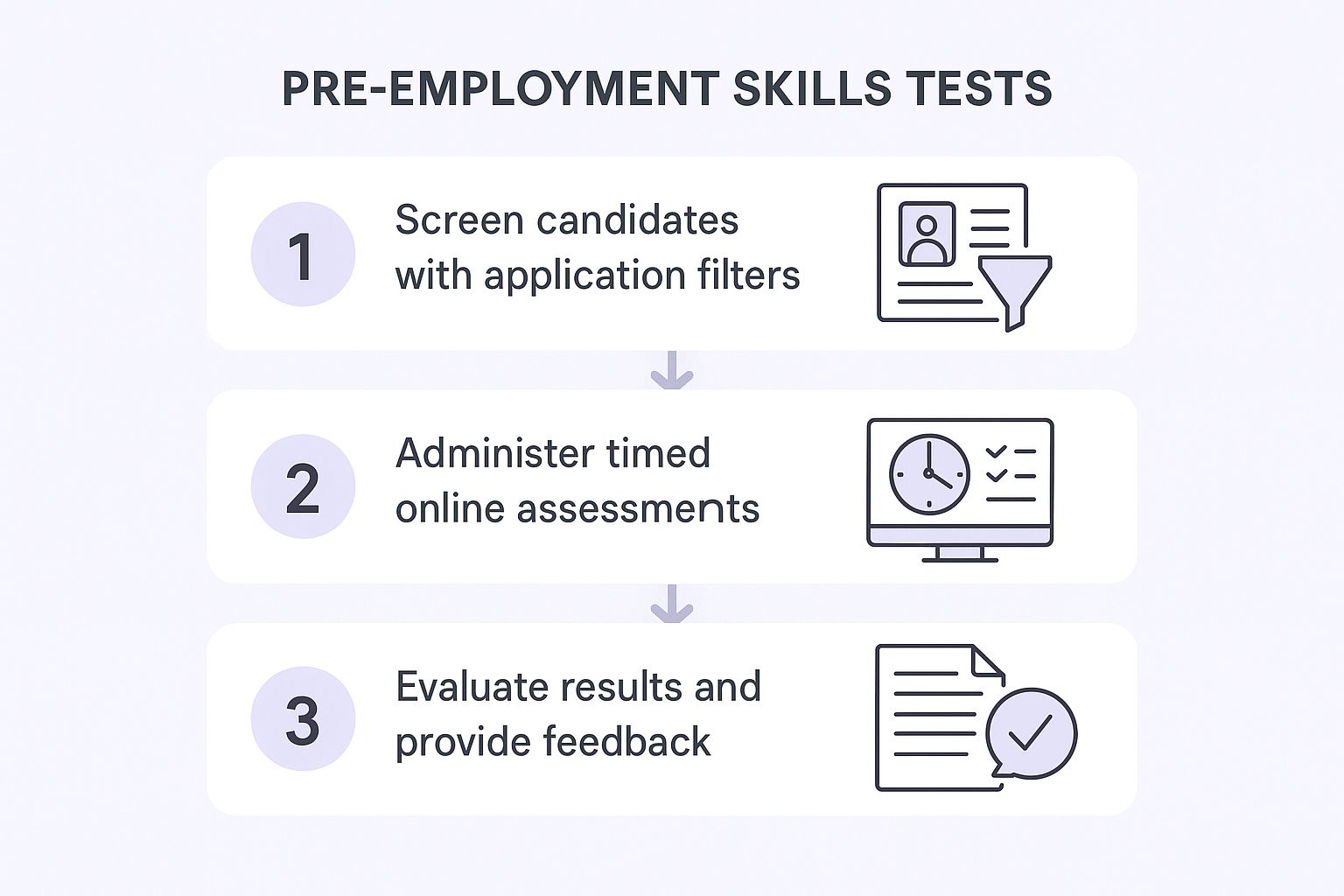
Pre-employment skills testing is a straightforward way to objectively verify a candidate's real-world abilities before you make a hiring decision. It’s about moving beyond what’s on a resume to get hard data on everything from technical expertise to problem-solving and communication, ensuring a much better fit between the candidate and the role.

Think of hiring without skills testing like buying a car based only on its brochure. The description looks great, the features sound impressive, and the photos are polished. But you wouldn't make a big investment like that without taking it for a test drive, would you?
This is exactly what pre-employment skills testing does. It’s the "test drive" for your job candidates, letting you see their capabilities in action. Resumes tell you what a candidate claims they can do; skills tests show you what they can actually do.
This move toward objective evaluation marks a fundamental shift in how modern companies approach hiring. Instead of relying on gut feelings, impressive-sounding college names, or how well someone performs in a single interview, businesses are turning to concrete data to build more effective teams.
This method gives you a much clearer and more reliable picture of a candidate's potential. By assessing the specific skills needed for the job, you can predict on-the-job performance with far greater accuracy. The core benefits here are pretty clear:
This table breaks down the key differences between the old way of screening and the new, skills-focused approach. It really highlights the move from subjective impressions to objective proof.
| Evaluation Aspect | Traditional Resume Screening | Pre-Employment Skills Testing |
|---|---|---|
| Primary Focus | Experience, education, keywords | Verifiable, job-relevant skills |
| Nature of Evidence | Self-reported claims, subjective | Objective, data-backed results |
| Bias Potential | High (unconscious bias, name bias) | Low (focus is on performance) |
| Predictive Power | Low to moderate | High |
| Efficiency | Slow, manual, time-consuming | Fast, automated, scalable |
| Candidate Experience | Passive, often lacks feedback | Engaging, interactive, provides insight |
As you can see, the contrast is stark. Skills testing provides the proof of performance that’s essential for making a confident hire and avoiding costly mistakes down the line.
A resume is a candidate's marketing document. A skills test is the product demonstration. The latter provides the proof of performance that is essential for making a confident hiring decision and avoiding costly mistakes.
The adoption of skills testing isn't just a fleeting trend; it’s a proven strategy used by the world's most successful organizations. For instance, roughly 80% of Fortune 500 companies use cognitive ability tests as a core part of their hiring. On top of that, 75% of The Times’ Top 100 Companies use psychometric testing to assess personality and role suitability.
These numbers point to a clear consensus among industry leaders: verifying skills upfront is critical to building a high-performing workforce. You can find more details in these skills-based hiring statistics.
By integrating pre-employment skills testing into your hiring workflow, you shift from hoping you’ve found the right person to knowing you have the data to back up your choice. This strategic approach minimizes risk, reduces bias, and ultimately leads to stronger, more capable teams.

Shifting from resume guesswork to data-backed decisions does more than just tweak one step in your hiring process. It creates a powerful ripple effect across your entire organization. Implementing pre-employment skills testing isn't just an HR task; it’s a core business strategy with a clear and compelling return on investment.
When you start prioritizing what a candidate can actually do over subjective impressions, you directly attack some of the most expensive and persistent headaches in talent management. The objective nature of skills tests cuts through hiring bias, naturally leading to more diverse teams that bring a wider range of perspectives to the table.
This is exactly why the market is exploding. The global pre-employment testing market is on track to blow past $5 billion by 2025, with experts predicting a 12-15% compound annual growth rate through 2033. This isn't just a trend; it's a fundamental shift as companies race to adopt tools that improve hire quality and slash turnover.
Let's look at a classic business problem: a company bleeding talent in its customer support department. They hired people who aced interviews and had flawless-looking resumes, yet many would crash and burn within six months, unable to handle the pace and complexity of real customer issues. The constant churn was a financial drain, wasting resources on recruiting and training replacements who often met the same fate.
Fed up, the leadership team flipped its strategy. Instead of relying on interviews alone, they rolled out a targeted skills test that simulated real customer scenarios. Candidates had to prove their problem-solving skills, typing speed, and communication tone right then and there.
The results were immediate and game-changing. The new hires who passed this assessment weren't just qualified on paper; they were demonstrably ready for the job from day one.
The transformation was undeniable: turnover in that role plummeted by over 60% within the first year. This didn't just save them thousands in hiring costs—it stabilized the team, boosted customer satisfaction scores, and improved morale across the board.
This story perfectly illustrates the direct line between accurate skills assessment and core business metrics. But the benefits reach far beyond filling one role. A well-designed skills testing program delivers strategic wins that fortify your entire operation. This is especially true when building global teams, as you can explore in our guide on why hiring remote workers from LATAM is a smart business move.
Here are some of the key impacts you can expect:
Of course, skills tests are just one piece of a comprehensive, data-driven hiring puzzle. Many organizations strengthen their process by also conducting thorough background checks to ensure a secure and reliable workforce.
Ultimately, skills testing elevates hiring from a game of chance into a predictable, data-informed strategy for growing your business.
Picking the right pre-employment skills test is a lot like a doctor choosing the right diagnostic tool. You wouldn’t use a stethoscope to check for a broken bone, right? In the same way, you can't use a coding challenge to see if a salesperson can actually sell. Each test is built to measure something specific, and combining them strategically is how you get a complete picture of a candidate's fitness for a role.
Thinking like a diagnostician helps you move past a one-size-fits-all approach. It's about pinpointing the exact skills that predict success on the job. Once you understand what each type of test is for, you can build an assessment that shows you what a candidate is truly capable of.
These are the most direct assessments you can use. They measure practical, job-specific knowledge and abilities—the tangible stuff. Think of them as the "lab tests" in your hiring toolkit. They give you clear, measurable data on whether someone can actually do the technical parts of the job.
If a role requires a specific, teachable skill, a hard skills test is non-negotiable.
Common examples include:
These tests are perfect for using early in the hiring process. They quickly filter out candidates who don't have the foundational technical chops needed to even get started.
While hard skills tests measure what a candidate already knows, cognitive ability tests measure how they think. These assessments dig into higher-level brain functions like problem-solving, critical thinking, numerical reasoning, and—crucially—their ability to learn on the fly. They are incredibly powerful predictors of job performance, especially for complex roles that demand quick thinking and adaptability.
The shift toward skills-based hiring is impossible to ignore. As of 2025, a massive 85% of employers have adopted these methods. And while soft skills tests are common, cognitive ability tests are catching up fast, with completions jumping 61% year-over-year in early 2025. You can see more of this data in the full 2025 State of Skills-Based Hiring report.
Technical skills might get a candidate’s resume noticed, but it’s their soft skills that determine if they'll actually succeed and stick around. These assessments evaluate interpersonal qualities like communication, teamwork, leadership potential, and resilience. You can teach someone a new software program, but teaching them accountability? That's a much taller order. The rising importance of these skills is a global trend, as seen in the latest skill development trends in LATAM.
A candidate's ability to collaborate, communicate effectively, and adapt to change is often a stronger indicator of long-term success than their initial technical expertise. These are the skills that build great teams and positive work cultures.
These tests are especially vital for customer-facing or leadership positions, where emotional intelligence and interpersonal finesse are the name of the game.
Situational Judgment Tests (SJTs) are where the rubber meets the road. They close the gap between knowing something in theory and applying it in practice. SJTs present candidates with realistic, work-related scenarios and ask them to choose the most effective response. It’s a brilliant way to assess a mix of soft skills, problem-solving, and practical knowledge all at once.
For instance, an SJT for a customer service manager might describe a scene with an angry customer and a frazzled employee. The candidate's chosen course of action immediately reveals their conflict-resolution style, empathy, and what they prioritize under pressure. SJTs offer a unique window into how someone will actually behave on the job, making them highly predictive for roles that require nuanced, real-world decision-making.
Choosing the right assessment depends entirely on the role you're hiring for. A great assessment strategy often involves a blend of different test types to create a holistic view of the candidate. Here’s a quick guide to help you match common job functions with the most effective tests.
| Job Role/Function | Primary Hard Skills Test | Recommended Soft Skills/Cognitive Test |
|---|---|---|
| Software Developer | Coding Challenge (e.g., Python, Java) | Problem-Solving, Attention to Detail, Critical Thinking |
| Sales Representative | CRM Proficiency (e.g., Salesforce) | Communication, Negotiation, Resilience, Situational Judgment |
| Marketing Manager | Digital Marketing Tools (e.g., Google Analytics) | Leadership, Strategic Thinking, Communication |
| Customer Support Agent | Typing Speed, Helpdesk Software Test | Empathy, Problem-Solving, Situational Judgment |
| Data Analyst | SQL Querying, Excel/Tableau Test | Critical Thinking, Numerical Reasoning, Attention to Detail |
| Graphic Designer | Adobe Creative Suite Task | Creativity, Communication, Time Management |
By tailoring your test selection to the specific demands of each position, you move from guessing to knowing. This targeted approach not only improves the quality of your hires but also ensures that you’re evaluating candidates on the skills that truly matter for success in their role.
So, you’re ready to move beyond resumes and gut feelings. Excellent. Building a great pre-employment skills testing program is a game-changer, but it’s not just about buying some software and flipping a switch. It’s about being deliberate.
Think of it like this: you’re building a high-performance engine for your hiring process. Every piece needs to be chosen carefully and installed correctly for the whole machine to run smoothly. Let’s break down exactly how to do that, step-by-step.
Before you even glance at a testing platform, you have to answer one fundamental question: what does “good” actually look like for this job? This is the most critical step, and skipping it is like trying to build a house without a blueprint.
Go beyond generic buzzwords on a job description. You need to conduct a real job analysis to pinpoint the 3-5 essential abilities that directly predict high performance. For a software developer, that might be proficiency in a specific language, logical problem-solving, and clean coding habits. For a sales rep, it could be persuasive communication, objection handling, and CRM proficiency.
This foundational work ensures your tests are not just relevant but legally defensible. Why? Because every question is directly tied to the actual demands of the job. It’s your north star for the entire process.
With your core competencies clearly defined, it’s time to find the right tool for the job. The market is crowded with options, so you need to be strategic.
Look for a platform that offers a solid library of validated tests that match your roles—everything from technical coding challenges to situational judgment tests for soft skills. Just as important is the user experience. Is it intuitive for your hiring team? Is it a frustrating, clunky experience for candidates?
Your ideal solution should also have key features like anti-cheating measures, robust analytics, and—crucially—the ability to integrate with your existing Applicant Tracking System (ATS). Great tools often leverage business process automation in HR to make the whole workflow feel effortless.
Now, where do you plug this new engine into your hiring process? Timing is everything.
If you test too late in the game, you’ve already wasted hours interviewing people who can’t do the job. If you test too early, you might scare off good candidates before they’ve even had a chance to get interested.
The sweet spot for most companies is right after the initial application review. This simple workflow shows how it fits together:

This approach lets you filter a large applicant pool objectively and efficiently. Your recruitment team can stop spending countless hours on manual sorting and instead focus their energy on the much smaller group of candidates who have already proven they have the skills.
This kind of efficiency is vital when you're scaling quickly, a challenge we dive into in our guide on effective onboarding processes when hiring remote talent from LATAM.
Key Takeaway: Using skills tests early respects everyone's time—yours and the candidates'. It focuses your team's energy on engaging with a smaller pool of highly qualified people who have already demonstrated their capabilities.
Transparency is your best friend here. A surprise test request can feel jarring and creates anxiety. Instead, be upfront about the process from the beginning.
Explain why you use skills tests and what they can expect. Frame it not as a pass/fail hurdle, but as their chance to show you what they can do, in a way a resume never could. Let them know it's just one part of a holistic evaluation. This simple communication builds trust and dramatically improves the candidate experience, which in turn boosts your employer brand.
Finally, it’s time to use the data. The goal isn’t to just hire the person with the highest score. That score is a single, powerful data point, but it’s not the whole story.
Use the test results as a conversation starter during the interview. You could ask a candidate to walk you through how they approached a specific problem on the assessment. "I saw you scored really well on the logic puzzle, but struggled a bit with the debugging section. Can you tell me what your thought process was there?"
This approach gives you a complete, three-dimensional view of each candidate. You get the objective data from the test combined with qualitative insights from the conversation. That’s how you hire for both skill and fit.

Putting a pre-employment skills testing program in place is a powerful move, but how you wield that power is what separates a successful hiring process from a flawed one. Just launching tests isn't enough; you have to make sure they are fair, effective, and legally sound. Think of it as the difference between using a blunt instrument and a surgical tool—precision and care are everything.
Following best practices doesn't just protect your organization legally and ethically. It also builds a much stronger employer brand by showing candidates you’re committed to a transparent and equitable process. This isn’t about adding bureaucratic hurdles; it’s about fine-tuning your hiring engine so it runs better for everyone involved.
The bedrock of any ethical testing program is using validated tests. This simply means the test has been scientifically shown to measure what it claims to measure and, crucially, that it directly correlates with performance on the job. Using a random online quiz to assess a data analyst’s skills isn’t just a waste of time—it’s a legal minefield.
Your guiding principle should always be job relevance. Every single question or task in an assessment must tie back to a core competency needed for that role. This simple check ensures you're evaluating candidates on what truly matters for success, not on arbitrary factors that can easily introduce bias.
A skills test is only as good as its connection to the actual job. If you can't draw a straight line from an assessment task to a daily responsibility, you shouldn't be using it. This focus on relevance is your best defense against claims of discrimination.
To really make sure your testing program is solid and gives you meaningful results, it helps to borrow from instructional design best practices. This approach helps structure tests logically so they assess skills in a truly meaningful way.
Fairness means creating a level playing field for every single candidate. This is where accessibility and transparency become non-negotiable. Your entire testing process must be inclusive and straightforward for all applicants to navigate.
Transparency builds trust. When candidates understand the "why" behind your methods, they are far more likely to have a positive experience, even if they don’t end up getting the job.
Maybe the most critical best practice is to remember that a test score is just one piece of the puzzle. It’s a powerful one, for sure, but it should never be the only reason for a hiring decision. Relying too heavily on a single number can cause you to overlook fantastic candidates who just had an off day.
The smartest approach is to use test results to inform your next steps, not dictate them.
This balanced approach helps you make a well-rounded, informed decision. It brings together objective data with the essential human element of hiring, ensuring you find candidates who are not just skilled, but are the right overall fit for your team.
The theory behind skills testing is one thing, but seeing it work in the real world is where its true value clicks. Let's move from the abstract to the practical and look at how actual companies have completely turned their hiring around.
These stories aren’t just interesting anecdotes—they’re blueprints for building smarter, more effective teams. From scrappy startups to massive corporations, the results all point in the same direction.
Picture this: a fast-growing tech startup was hemorrhaging money because of developer turnover. They kept hiring engineers who looked brilliant on paper and charmed their way through interviews, only to buckle under the pressure of the company's fast-paced workflow. Projects stalled, and resources were circling the drain.
Their fix was to introduce mandatory coding challenges right at the start of the hiring funnel. These weren't abstract puzzles; they were practical tests that mirrored the exact kind of work their developers handled daily. Candidates had to prove they could write clean code and solve problems directly related to the company’s tech stack.
The results were immediate. By shifting the focus to what candidates could do instead of what they said they could do, the startup reduced bad hires on their development team by 40% in the first year. It was a game-changer that didn't just save money but also boosted team productivity and morale.
Another company, a dynamic marketing agency, had a different problem. Their individual creatives were brilliant, but projects kept getting bogged down by clashing workflows and poor communication. The leadership realized they weren't just hiring designers and copywriters; they were hiring for people who could collaborate effectively when the pressure was on.
So, they added Situational Judgment Tests (SJTs) to their process. They presented candidates with realistic work scenarios, like how they'd handle contradictory client feedback or resolve a creative disagreement with a teammate. Their answers gave the hiring team a direct window into their communication style and problem-solving skills.
This simple change to their pre-employment skills testing led to a huge improvement in team chemistry. Projects started running like clockwork, creative quality became more consistent, and new hires slid right into the company's collaborative culture.
Finally, let's look at a large corporation that was drowning in applications for its customer service department. Their traditional interview process was slow and clumsy, often failing to spot which candidates could actually thrive in a high-stress, customer-facing role.
They rolled out a two-pronged assessment:
This simple combination allowed them to filter their massive applicant pool with incredible speed, pinpointing people who had both the technical chops and the right personality. The result? A much faster hiring cycle, a major drop in time-to-hire, and a clear spike in customer satisfaction scores, all because their agents were better equipped from day one.
Switching up your hiring process always brings a few questions to the surface. It's only natural. Let's tackle some of the most common ones we hear about pre-employment skills testing so you can move forward with confidence.
Yes, absolutely—as long as you use them the right way. The magic word here is job relevance.
Any test you use must directly measure a skill that's critical for the job. If you can't draw a straight line from a test question to a core responsibility of the role, you could be wandering into discrimination territory.
Beyond that, keeping things fair and accessible is non-negotiable. This means you need to:
This is a common worry, but it’s usually rooted in how the test is presented. A surprise test feels like a pop quiz. A well-explained assessment, on the other hand, feels like an opportunity.
Frame the test as a chance for candidates to show you what they can do, not just what they've written on a resume. When you explain that it's a fair, objective way for them to showcase their talent, the whole dynamic changes. It improves their experience and signals that you're a serious, professional employer. A short, relevant test shows you respect their time and attracts confident candidates who are ready to prove their skills.
The real risk isn't scaring away good candidates; it's hiring unqualified ones. A well-designed testing process filters for skill and commitment, which is exactly what you want.
A test score is a powerful piece of data, but it’s just one piece. It should never be the only reason you hire—or don't hire—someone. The best way to use test results is as a guide for the rest of your hiring process.
Think of a score as a conversation starter. Did a candidate crush the technical portion but struggle with a communication prompt? Great, now you have something specific to dig into during the interview. Ask them to walk you through their thought process on a question they found tricky. This approach blends objective data with real human insight, giving you a much richer picture of their problem-solving abilities, self-awareness, and how they’d truly fit into your team. Use scores to inform your decisions, not dictate them.
